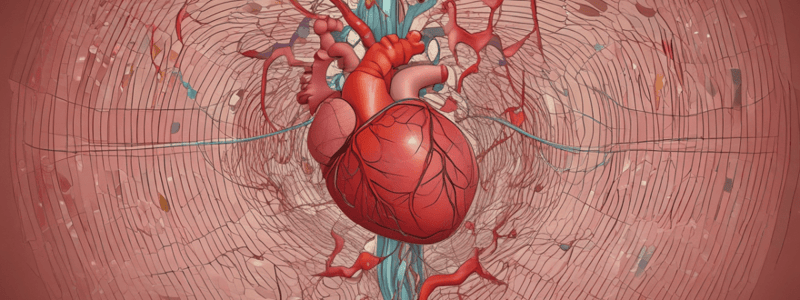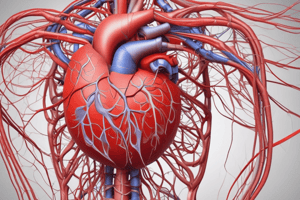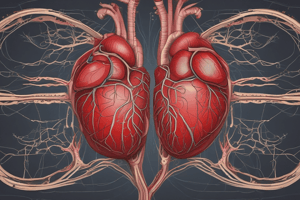Podcast
Questions and Answers
What is the main function of the cardiovascular system?
What is the main function of the cardiovascular system?
- To deliver oxygen and nutrients and to remove carbon dioxide and other waste products (correct)
- To pump blood throughout the body
- To regulate body temperature
- To remove oxygen and nutrients from the body
What is the outer layer of the pericardium?
What is the outer layer of the pericardium?
- Serous fluid
- Epicardium
- Parietal pericardium (correct)
- Visceral pericardium
Which chamber of the heart receives oxygenated blood from the lungs?
Which chamber of the heart receives oxygenated blood from the lungs?
- Right atrium
- Right ventricle
- Left atrium (correct)
- Left ventricle
What is the function of the right ventricle?
What is the function of the right ventricle?
What is the purpose of the serous fluid in the pericardium?
What is the purpose of the serous fluid in the pericardium?
What are the two upper chambers of the heart?
What are the two upper chambers of the heart?
What is the primary function of the aorta?
What is the primary function of the aorta?
What is the function of the sinoatrial node?
What is the function of the sinoatrial node?
What is the formula for cardiac output (CO)?
What is the formula for cardiac output (CO)?
Which of the following valves controls blood flow between the right atrium and ventricle?
Which of the following valves controls blood flow between the right atrium and ventricle?
What is the main difference between arteries and veins?
What is the main difference between arteries and veins?
What is the function of the coronary circulation?
What is the function of the coronary circulation?
What is the term for the pressure wave of blood that can be felt in the arteries?
What is the term for the pressure wave of blood that can be felt in the arteries?
What is the normal range for diastolic blood pressure?
What is the normal range for diastolic blood pressure?
What is the function of the atrioventricular node?
What is the function of the atrioventricular node?
What is the term for the exchange of substances between the blood and tissue cells?
What is the term for the exchange of substances between the blood and tissue cells?
Study Notes
Cardiovascular System
- A closed system of the heart and blood vessels that delivers oxygen and nutrients, and removes carbon dioxide and waste products.
Heart
- Has a double serous membrane called pericardium, with a visceral and parietal layer.
- Has four chambers: right and left atria (receiving chambers) and right and left ventricles (discharging chambers).
- Right atrium receives deoxygenated blood from the body, while left atrium receives oxygenated blood from the lungs.
- Right ventricle sends blood to the lungs, and left ventricle sends blood to the body through the aorta.
Heart Valves
- Allow blood to flow in only one direction, with four valves: atrioventricular valves (bicuspid and tricuspid) and semilunar valves (pulmonary and aortic).
- Valves open as blood is pumped through and are held in place by chordae tendineae.
Heart Associated Great Vessels
- Aorta leaves the left ventricle, while pulmonary arteries leave the right ventricle.
- Vena cava enters the right atrium, and pulmonary veins enter the left atrium.
Coronary Circulation
- The heart has its own nourishing circulatory system, with coronary arteries and cardiac veins that empty into the right atrium via the coronary sinus.
Heart Conduction System
- Intrinsic conduction system sets the pace, with the sinoatrial node as the pacemaker.
- Contraction is initiated by the sinoatrial node, with sequential stimulation occurring at other autorhythmic cells.
Heart Contractions
- Cardiac output (CO) is the amount of blood pumped by each side of the heart in one minute, calculated as CO = heart rate (HR) x stroke volume (SV).
- Heart rate can be increased or decreased to change cardiac output.
Regulation of Heart Rate
- Increased heart rate is stimulated by the sympathetic nervous system, hormones, and exercise.
- Decreased heart rate is stimulated by the parasympathetic nervous system, high blood pressure, or decreased blood volume.
Blood Vessels
- The vascular system takes blood to the tissues and back, with five types: arteries, arterioles, capillaries, venules, and veins.
- Walls of arteries are the thickest, while lumens of veins are larger.
- Capillary walls are only one cell layer thick, allowing for exchanges between blood and tissue.
Blood Vessel Anatomy
- Three layers (tunics) make up the blood vessel wall: tunic intima, tunic media, and tunic externa.
- Smooth muscle in the tunic media is controlled by the sympathetic nervous system.
Movement of Blood Through Vessels
- Most arterial blood is pumped by the heart, while veins use the milking action of muscles to help move blood.
Capillary Beds
- Capillary beds consist of two types of vessels: vascular shunt and true capillaries.
- True capillaries are exchange vessels where oxygen and nutrients cross to cells, and carbon dioxide and waste products cross into blood.
Capillary Exchange
- Substances are exchanged due to concentration gradients, with oxygen and nutrients leaving the blood and carbon dioxide and waste products leaving the cells.
Blood Pressure
- Measurements are made on the pressure in large arteries, with systolic pressure at the peak of ventricular contraction and diastolic pressure when ventricles relax.
- Blood pressure can be affected by neural factors, renal factors, temperature, chemicals, and diet.
Variations in Blood Pressure
- Normal range is 90-140 mm Hg systolic and 60-90 mm Hg diastolic.
- Hypotension is low systolic pressure (below 90 mm Hg), while hypertension is high systolic pressure (above 140 mm Hg).
Studying That Suits You
Use AI to generate personalized quizzes and flashcards to suit your learning preferences.
Related Documents
Description
This lecture covers the general organization and functions of the cardiovascular system, including the heart and blood vessels. It also explains measurements of CVS.





